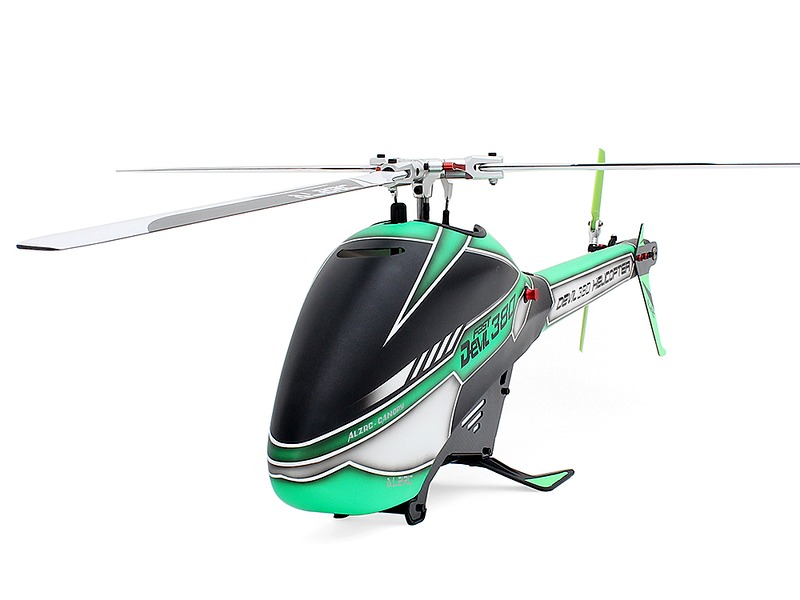What are the parts of a RC helicopter?

A Radio Controlled (RC) helicopter is a model aircraft that is controlled remotely by a pilot using a transmitter and receiver. The parts of an RC helicopter include the main frame, rotor blades, motor, servos, receiver, transmitter, and battery.
The main frame of an RC helicopter is the central part of the aircraft and serves as the main structure to which all other components are attached. It is generally made of aluminum, carbon fiber, or fiberglass, and is designed to be lightweight and durable.
The rotor blades of an RC helicopter are responsible for providing lift and stability to the aircraft. They are usually made of carbon fiber or fiberglass and are attached to the main frame by a hub. The blades are typically curved, and the angle of attack can be adjusted to create more lift or reduce drag.
The motor of an RC helicopter is responsible for providing power to the rotor blades. It is typically a brushless electric motor, though some models may be powered by a gasoline or nitro engine. The motor is connected to the rotor blades via a gearbox, which is responsible for transferring power from the motor to the blades.
Servos are the small electronic devices that are responsible for controlling the movement of the rotor blades. They are connected to the main frame and the receiver, and they receive signals from the transmitter to control the movement of the blades.
The receiver is the electronic device that is responsible for receiving the signals from the transmitter. It is connected to the servos, and it interprets the signals from the transmitter to move the servo motors.
The transmitter is the handheld device that is used to control the RC helicopter. It is usually a two-way radio, and it sends signals to the receiver on board the RC helicopter.
The battery is the power source for the RC helicopter. It is typically a rechargeable lithium-ion battery, though some models may be powered by a gasoline engine or nitro engine. The battery is connected to the motor and the receiver, and it provides power for the operation of the RC helicopter.
In summary, an RC helicopter consists of a main frame, rotor blades, motor, servos, receiver, transmitter, and battery. The main frame serves as the structure to which all other components are attached, and the rotor blades provide lift and stability. The motor is responsible for providing power to the rotor blades, and the servos control the movement of the blades. The receiver interprets the signals from the transmitter, and the battery provides power for operation. All of these components work together to allow the RC helicopter to be remotely controlled.
Comments / Question
2. Gyroscope: A gyroscope helps to stabilize the helicopter and keep it from spinning out of control.
3. Crash Resistant Materials: Many RC helicopters are made with crash resistant materials such as foam or plastic to help protect the helicopter in the event of a crash.
4. Propeller Guards: Propeller guards help to protect the propellers from damage in the event of a crash.
5. Emergency Stop: Many RC helicopters come with an emergency stop feature that will automatically shut off the power to the helicopter in the event of an emergency.
2. Durability: Professional RC helicopters are built to last and are typically more durable than toy RC helicopters which are usually made of cheaper materials.
3. Control: Toy RC helicopters usually have fewer controls than professional RC helicopters, which often have a variety of different settings and features.
4. Performance: Professional RC helicopters typically have better performance than toy RC helicopters. They can fly higher and faster, and can typically handle more complex maneuvers.
5. Safety: Professional RC helicopters are designed to be safer than toy RC helicopters and are typically equipped with various safety features such as a failsafe system or an auto-shutoff feature.
2. Almost-Ready-to-Fly (ARF) Helicopters: These helicopters require some assembly and setup. Usually, you need to install the main rotor blades and linkages, as well as the radio system.
3. Bind-N-Fly (BNF) Helicopters: These helicopters are similar to ARF helicopters but they include a radio system already installed. You just need to bind the transmitter to the receiver and you are ready to fly.
4. Kit Helicopters: These helicopters come in pieces and require assembly. You need to install the frame, motor, servos, and other components before you can fly.
5. Mini Helicopters: These helicopters are smaller than traditional RC helicopters and are designed for indoor flying. They are usually ready-to-fly and require minimal assembly.
2. Receiver: The receiver is a device mounted on the helicopter that receives signals from the transmitter.
3. Main Rotor: This is the propeller that generates lift and enables the helicopter to fly.
4. Tail Rotor: This is the smaller propeller at the rear of the helicopter that provides control and stability.
5. Battery: This is the power source for the helicopter.
6. Servos: These are electronic motors that are used to move the control surfaces of the helicopter.
7. Gyroscope: This is an electronic device that senses the helicopter’s orientation and helps to keep it stable.

